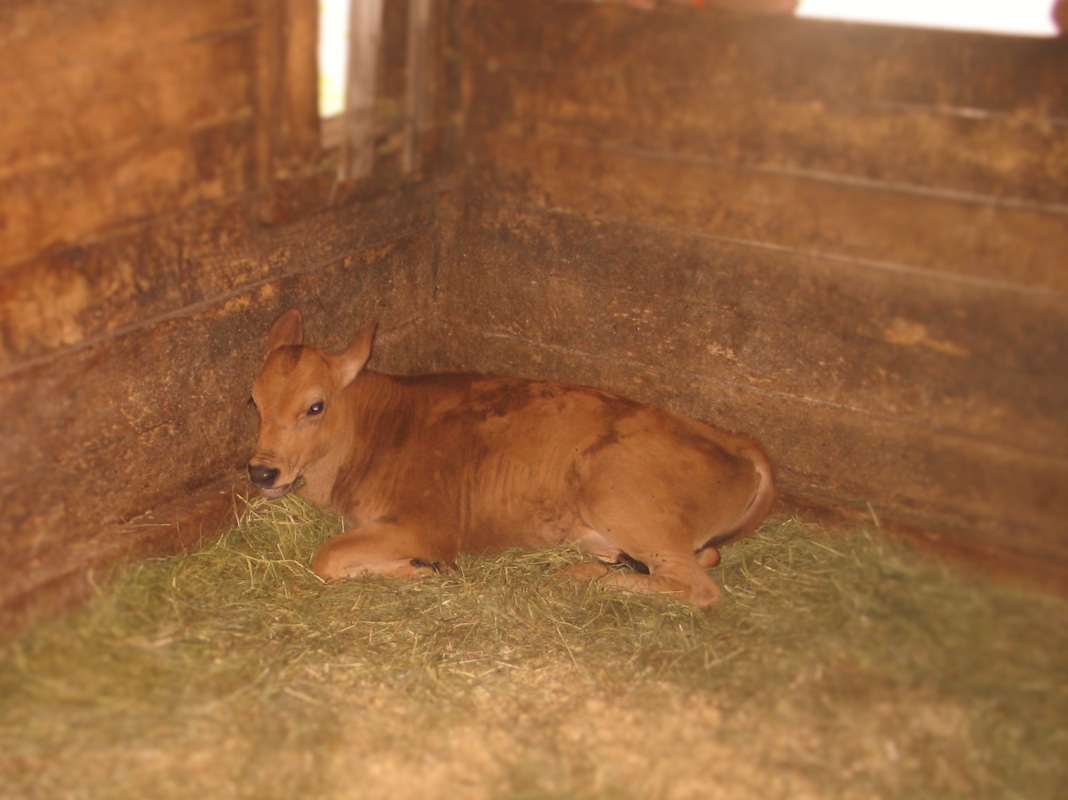raised them with their mothers, we have raised them with visiting privileges, we have raised them, after the first few days, to drink from a bucket. We have never used a “nipple pail” although we have been told firmly that it is the only way to do things. We wouldn’t presume to disagree but our calves have apparently never read those books or talked to enough other calves to get this fixed in their minds.
(There is a good deal of hand-wringing about the indisputable fact that city kids have no idea where milk comes from. I have news. A calf that has been properly raised doesn’t know either. Put mother and a bucket in front of him and he will go for the bucket every time.) When we rebuilt that part of the barn intended to hold the stock - this was years ago - we designed the space so that there were three Jersey-sized stanchions for cows and two small stalls for calves. There were times, when there were a goodly number of children still at home, when there were two cows milking and there were times when all three stanchions had their occupants. For reasons that are not clear to me the calf stalls did not get used all that much. Over the years the stalls tended to fill up, not with calves, but with empty feed bags, the garbage can that held barn cat chow, odds and ends of electric fence wire too long to throw out but too tangled to be worth untangling, plastic buckets that had lost their bail handles but were only cracked about half-way down the side, and a fine wooden hopper-type chicken feeder we never used for feeding chickens but kept supplied for the cats from the afore-mentioned garbage pail. Calves tended to be kept in the big box stall where they had been born and where they had lots of room to whee-ha around. For some reason Barlaam was invited to try a stall out for size. The stalls have a nice high manger in front of them which is handy for keeping hay within munching distance as well as locating a milk bucket so that the calf can show his appreciation by snorting and blowing, but most of the milk (well, a lot of it) stays in the bucket. Barlaam seemed to find the stall quite acceptable. He enjoyed drumming on the sides of the stall with his hooves, a particularly satisfying manoeuvre because every time he would whack the boards the barn cats, who were clustered around a milk dish on the walkway behind him, would leap about five feet in the air and come down running for cover. As Barlaam grew the stall became smaller, until finally, my wife and I decided it really was time to get him into a stanchion. I had put the moment off much longer than I had intended to because a steer in a stanchion is usually an untidy mess and Barlaam in his stall was remarkably tidy. To my surprise he did not give us a lot of trouble. The last calf (also a steer) who had spent his early life in one of the stalls had felt strongly that if he was going anywhere (in that case “out on grass” was where he was going) his stall should come with him. Barlaam did do the classic cow-who-does-not-approve-of-the-turn-events-are-taking routine by collapsing into an untidy but immoveable lump at one point. After a bit of deep breathing, however, he was up and even succeeded in crossing the gutter, with assistance. So now he is out at least as far as a stanchion. The next big event in his life (and, inevitably, ours) will be his introduction to the out-of-doors and the electric fence. Another milestone. I always hope the experience will be uneventful, but it rarely is. |
Words & ImagesWe moved to our farm in Sussex, New Brunswick from Toronto in 1977, only moving away in 2014. Archives
April 2020
Categories
All
|

